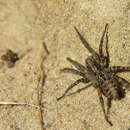en
names in breadcrumbs


The spider family Lycosidae (wolf spiders) includes 2396 described species according to Platnick (2013), ranking it among the most species-rich of the 112 spider families recognized by Platnick (only seven spider families include more than 2000 described species). Nearly 250 lycosid species are known from North America north of Mexico (Dondale 2005). Lycosids are among the most common and widespread spiders, ranging from the Arctic to the subtropics. They are found in an extremely wide variety of habitats, including the coastal intertidal zone.
The unusual lycosid eye arrangement makes lycosids generally easy to recognize as such. Typically, there is a row of four small anterior eyes; two large and forward-facing posterior median eyes (PME); and well behind the PME, a pair of large posterior lateral eyes (PLE), which usually face to the side or even backwards. Wolf spiders have excellent vision and because of the arrangement of their eight eyes, they are able to see in all directions. Courtship in lycosids often includes a strong visual component (e.g., waving legs or palps).
Nearly half of the lycosid species found in North America north of Mexico are in the genera Pardosa (which have nearly perpendicular spines on their hind legs) or Pirata (these small spiders usually have a dark tuning fork-shaped mark on the cephalothorax).
Many lycosids are nocturnal or crepuscular (active at dawn or dusk), but others hunt during the day. Most lycosids do not build a capture web (in North America, only Sosippus species build webs) but they do use a dragline, which is laid down as they wander and provides an indirect mode of communication between individuals. Female lycosids exhibit unusual parental care. After constructing an egg sac, the female attaches it to her spinnerets and carries it with her as she hunts (in contrast, females of most species in the closely related family Pisauridae carry their round egg sac under the body, grasping it with their chelicerae and pedipalps). When the young emerge from the egg sac, they clamber onto her body (mainly on the abdomen, but sometimes spilling onto her cephalothorax). The young ride about on their mother for some days as they grow, then disperse.
Wolf spiders are mainly sit-and-wait predators, pouncing on prey that passes too close. Many wolf spiders build burrows, ranging from temporary shallow holes just a few centimeters deep to silk-lined tubes extending well into the ground. The burrows of some species may be marked by turrets of silk and debris or a silk sheet door similar to those of trapdoor spiders.
Dondale (2005) includes key references that provide an excellent entry into the literature on lycosid courtship and mating behavior, life histories, hunting behavior, and taxonomy.
(Dondale 2005 and references therein; Bradley 2013)